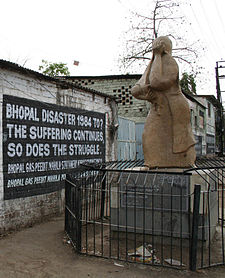
Back Bhopal-ramp Afrikaans Chemiekatastrophe von Bhopal ALS كارثة بوبال Arabic ভূপাল দুৰ্ঘটনা Assamese Bhopal fəlakəti Azerbaijani Бхапальская катастрофа Byelorussian Бопалска катастрофа Bulgarian ভোপালের বিপর্যয় Bengali/Bangla Desastre de Bhopal Catalan Bhópálská katastrofa Czech
 Memorial by Dutch artist Ruth Kupferschmidt for those killed and disabled by the 1984 toxic gas release | |
| Date | 2 – 3 December 1984 |
|---|---|
| Location | Bhopal, Madhya Pradesh, India |
| Coordinates | 23°16′51″N 77°24′38″E / 23.28083°N 77.41056°E |
| Also known as | Bhopal gas tragedy |
| Cause | Methyl isocyanate leak from Union Carbide India Limited plant |
| Deaths | At least 3,787; over 16,000 claimed |
| Non-fatal injuries | At least 558,125 |
The Bhopal disaster or Bhopal gas tragedy was an industrial accident. It happened at a Union Carbide subsidiary pesticide plant in the city of Bhopal, Madhya Pradesh, India. On the night of 2-3 December 1984, the plant released approximately 40 tons of toxic methyl isocyanate (MIC) gas. More than 500,000 people were exposed to toxic gases.
The mixture of poisonous gases flooded the city. There was great panic as people woke up with a burning sensation in their lungs. Thousands died immediately from the effects of the gas. Many were trampled in the panic that followed. The first official immediate death toll was 3,598 in 1989. Another estimate is that 8,000 died within two weeks, and that 8,000 more have since died from gas-related diseases.[1][2]
The Bhopal disaster is frequently cited as the world's worst industrial disaster.[1][2][3][4][5] The International Medical Commission on Bhopal was established in 1993 to respond to the long-term health effects of the disaster. The owner of the factory, UCIL, was majority owned by UCC, with Indian Government-controlled banks and the Indian public holding a 49.1% stake. In 1989, UCC paid $470 million to settle litigation stemming from the disaster. In 1994, UCC sold its stake in UCIL to EverReady Industries India Limited, which later merged with McLeod Russel (India) Ltd. Eveready ended clean-up on the site in 1998, when it ended its 99-year lease and turned over control of the site to the state government of Madhya Pradesh. Dow Chemical Company purchased UCC in 2001, seventeen years after the disaster.
- ↑ 1.0 1.1 Eckerman (2001).
- ↑ 2.0 2.1 Eckerman (2004).
- ↑ Chouhan et al. (1994, 2005).
- ↑ "Bhopal - The world's worst industrial disaster". Greenpeace. Archived from the original on 2008-09-16. Retrieved 2009-02-25.
- ↑ Simi Chakrabarti. "20th anniversary of world's worst industrial disaster". Australian Broadcasting Corporation.